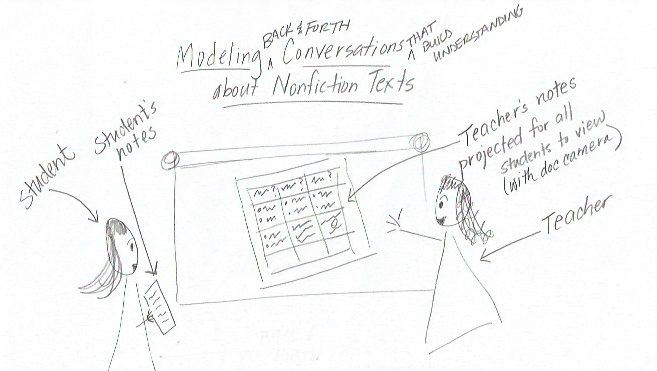
How do we help students have back-and-forth conversations about nonfiction that build understanding? Conversations that include continually returning to their notes and the text to think about what to say next?
I help students start to do this by demonstrating a conversation with a student-partner…
- I start by asking a student-volunteer to be my conversation partner.
- I ask the student volunteer to come to the front of the room WITH her notes and/or the text.
- I project my notes about the text or the annotated text for all students to view. For example, if we have completed or started taking notes on an inquiry chart – I will post my inquiry chart for all students to view.
- I pose a clear question for my partner and I to discuss like “What are critical components of an ecosystem?” or “How did members of the Jewish resistance reveal their courage?”
- I encourage her to look at her notes and think about what she wants to say before she responds. I might say, “What do you see in your notes that you want to talk about when we think about answering this question?”
- After she responds, I demonstrate how I listened to my partner and how I use what I heard her say and my notes (I point to specific details in my notes) to think about what to say next. For example, I might say, “I heard you say…and I have that in my notes right here. I’m thinking about what I can add to that. Let me look at my notes. (Pause to visibly skim in front of students.) Oh, yes. I want to add this to what you said…”
- Then I prompt the student to be strategic in contributing to our conversation. I might say, “Now what can you contribute to what we’ve both just said. Look back at your notes.”
- The student and I continue moving back and forth, continually thinking about what was said and looking at our notes to think about how to build meaning.
Other moves I make with my conversation partner…
- “I wrote a note about this, but I didn’t understand when the author of this text wrote that…what did you think about that?”
- “I never realized that…until I read in the text that…”
- “I think I heard you say…what did you mean by that?”
- “When I read…I started wondering about…but I never figured that out…”
And so forth.
The critical moves during this demonstration include –
- Modeling looking at my notes to decide what to say
- Prompting the student to look back at her notes before responding
- During the demonstration, taking several turns between partners, turns that build on what was already said
- During the demonstration, being explicit with students about what’s happening like saying, “Look at how I used my notes to think about what to say…” or “I just heard my partner say and I don’t understand that so I’m going to ask her to clarify…”
- Modeling asking for clarification or sharing what you didn’t understand or didn’t remember, etc.
But this is not all…when students turn to think pair share after this demonstration–I lean in to listen and coach with prompts like –
- What did your partner just say that you can build on?
- Look back at your notes. What did your partner already say? What do you see in your notes that will help you add on to that?
- Did you understand what your partner said? Is there a part of what she said that you need to hear again? Or ask for clarification about?
Hope this helps.
S
